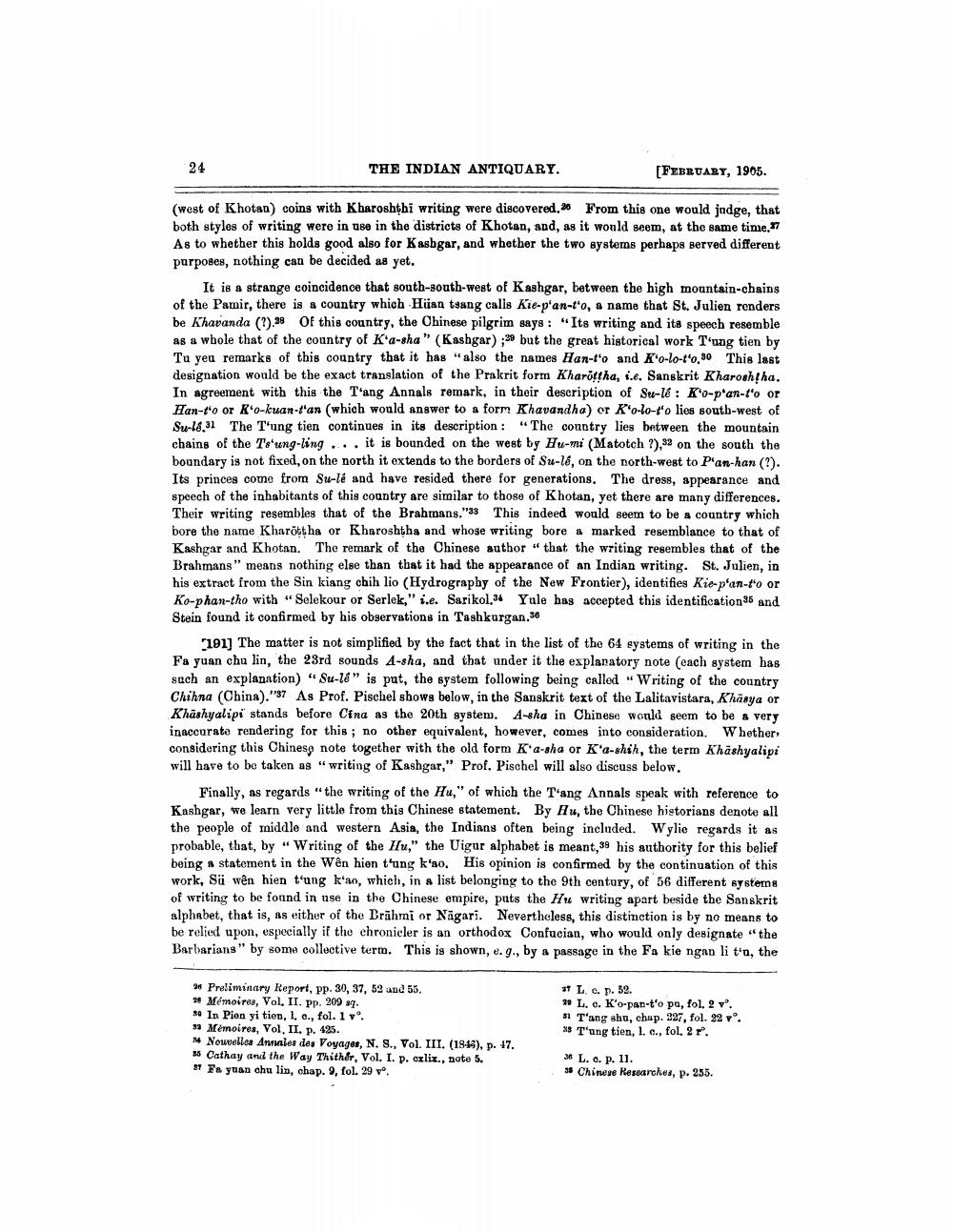________________
THE INDIAN ANTIQUARY.
FEBRUARY, 1905.
(west of Khotan) coins with Kbaroshthi writing were discovered. From this one would judge, that both styles of writing were in uso in the districts of Khotan, and, as it would seem, at the same time.7 As to whether this holds good also for Kasbgar, and whether the two systems perhaps served different purposes, nothing can be decided as yet.
It is a strange coincidence that south-south-west of Kashgar, between the high mountain-chains of the Pamir, there is a country which Hujan tsang calls Kie-pan-to, a name that St. Julien renders be Khavanda (1). Of this country, the Chinese pilgrim says: "Its writing and its speech resemble as a whole that of the country of K'a-sha" (Kashgar) ;29 but the great historical work Tung tien by Tu yeu remarks of this country that it has also the names Han-to and Ko-lo-t'0,80 This last designation would be the exact translation of the Prakrit form Kharöttha, i.e. Sanskrit Kharoshtha. In agreement with this the Tang Annals remark, in their description of Su-lé: Ko-p'an-t'o or Han-to or Ko-kuan-t'an (which would answer to a form Khavandha) or K'o-lo-to lies south-west of Su-18.31 The Tung tien continues in its description : "The country lies between the mountain chains of the Tsung-ling ... it is bounded on the west by Hu-mi (Matotch ?), on the south the boundary is not fixed, on the north it extends to the borders of Su-16, on the north-west to P'an-han (?). Its princes come from $u-le and have resided there for generations. The dress, appearance and speech of the inhabitants of this country are similar to those of Khotan, yet there are many differences. Their writing resembles that of the Brahmans."33 This indeed would seem to be a country which bore the name Kharött ha or Kharoshtha and whose writing bore a marked resemblance to that of Kashgar and Khotan. The remark of the Chinese author "that the writing resembles that of the Brahmans" means nothing else than that it had the appearance of an Indian writing. St. Julien, in his extract from the Sin kiang chih lio (Hydrography of the New Frontier), identifies Kie-pan-to or Ko-phan-tho with "Selekour or Serlek," i.e. Sarikol.34 Yule has accepted this identifications and Stein found it confirmed by his observations in Tashkurgan.36
191) The matter is not simplified by the fact that in the list of the 64 systems of writing in the Fa yuan chu lin, the 23rd sounds 4-sha, and that under it the explanatory note (cach system has such an explanation) "Su-lé" is put, the system following being called Writing of the country Chihna (China)."37 As Prof. Pischel shows below, in the Sanskrit text of the Lalitavistara, Khāsya or Khashyalipi stands before Cina as the 20th system. A-sha in Chinese would seem to be a very inaccurate rendering for this ; no other equivalent, however, comes into consideration. Whether considering this Chinesg note together with the old form K a-sha or K'a-shin, the term Khashyalipi will have to be taken as "writing of Kashgar," Prof. Pischel will also discuss below.
Finally, as regards the writing of the Hu," of which the T'ang Annals speak with reference to Kashgar, we learn very little from this Chinese statement. By Hlu, the Chinese historians denote all the people of middle and western Asia, the Indians often being included. Wylie regards it as probable, that, by "Writing of the Fu," the Uigur alphabet is meant,88 his authority for this belief being a statement in the Wên hion t'ung k'ao. His opinion is confirmed by the continuation of this work, Sü wên hien t'ung k'an, which, in a list belonging to the 9th century, of 56 different systems of writing to be found in use in the Chinese empire, puts the Hu writing apart beside the Sanskrit alphabet, that is, as either of the Brāhmi or Nagari. Nevertheless, this distinction is by no means to be relied upon, especially if the chronicler is an orthodox Confucian, who would only designate "the Barbarians" by some collective term. This is shown, e.g., by a passage in the Fa kie ngan li t'n, the
*Preliminary Report, pp. 30, 37, 52 and 55. 20 Mémoires, Vol. II. Pp. 209 sq. 80 In Pien yi tien, 1. o., fol. 1v. 30 Mémoires, Vol. II, p. 425.
Nowvelloa Amales des Voyages, N. S., Vol. III. (1945), p. 47. 1 Cathay and the Way Thithér, Vol. I. p. exlix., note 5. #7 F# yuan chu lin, chap. 9, fol. 29 v.
*L. c. p. 32. 30 L. e. K'o-pan-t'o pa, fol. 2 v. 31 Tang shu, chap. 327, fol. 22 v°. 35 Tung tien, 1. c., fol. 2 r.
** L. o. p. 11. * Chinese Researches, p. 255.




